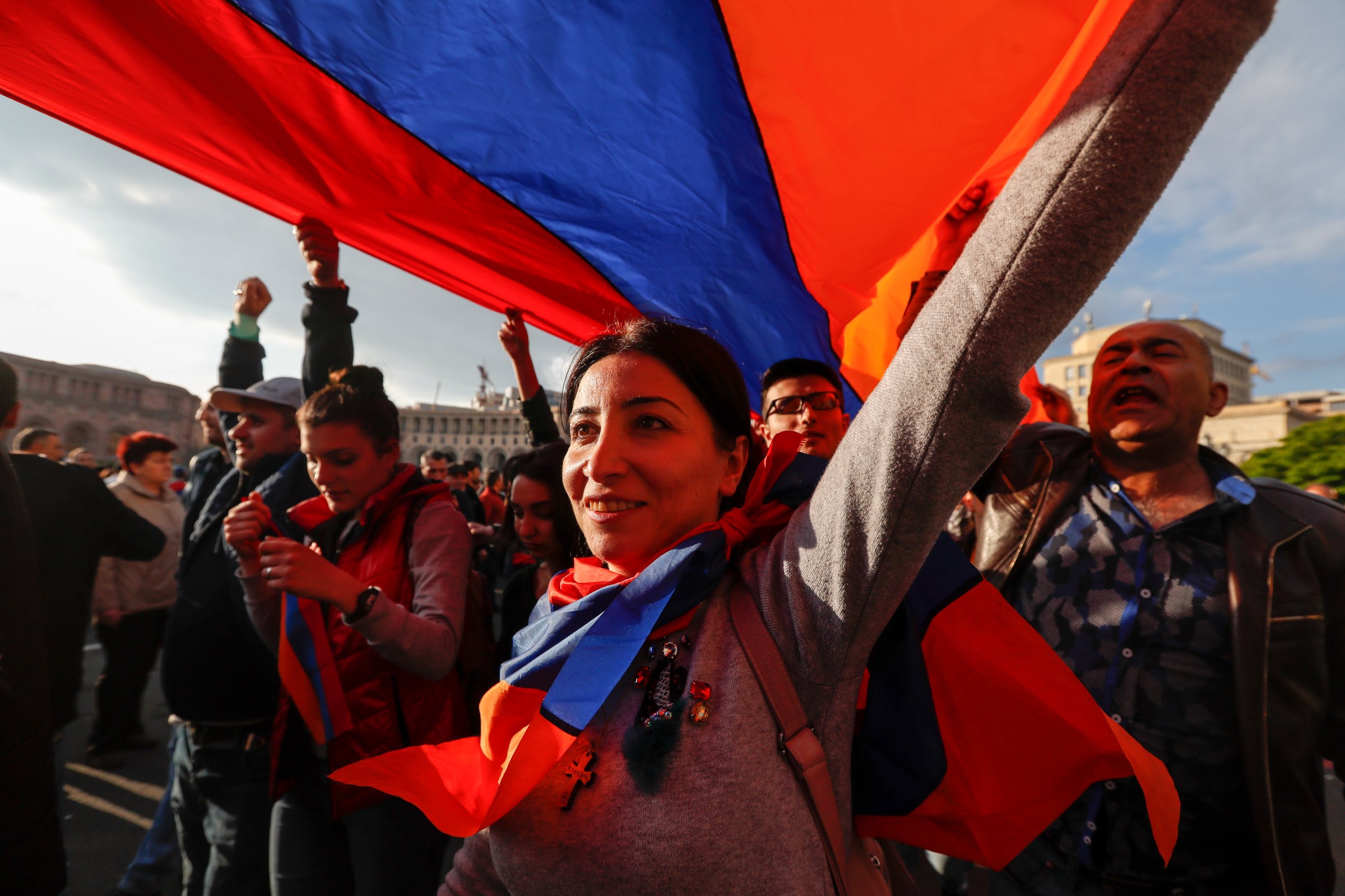
April 24 marks Armenia’s Genocide Remembrance Day, when many people both in the country and around the world are expected to take to the streets in remembrance of the estimated 1.5 million Armenians killed by Ottoman Turks in 1915. Yet Armenia has already seen mass protests in the run up to the day, in a sweeping, surprise political upheaval that forced Prime Minister Serzh Sargsyan to tender his resignation Monday after 10 consecutive days of demonstration. Dubbed Armenia’s “peaceful revolution” by some observers, the future of the country and its relationship with Russia face an uncertain path.
What happened?
Sargsyan, now 63, ruled the former Soviet republic for 10 years, and previously held power as Armenia’s President. Last week, Sargsyan worked his way around a term limit by engineering a parliamentary vote that transferred the power of the presidency to the Prime Minister; a role he assumed due to his right-wing Republican Party’s dominance in the Parliament. Thousands of anti-government protestors opposed this move, the Associated Press reports, with turnouts spreading across the country’s cities and numbering 50,000 in the capital Yerevan Sunday.
Popular protest leader Nikol Pashinian met Sunday with Sargsyan, but the summit ended in hostility as Pashinian demanded the Prime Minister’s resignation and was detained overnight. However, in a surprise statement on his website the following day, Sargsyan said “Nikol Pashinian was right. I was wrong. The movement on the streets is against my rule. I’m complying with their demands.” A spokesman for Sargsyan told the BBC that his resignation was “a clear demonstration of democracy in force.” Protests turned to celebrations in Yerevan, as streams of Armenian flags waved among the crowds.

Why now?
Sargsyan’s move last week was seen by many as an attempt to reinstate himself in a position of power, as presidential term limits forced him out of office in March this year. Parallels were drawn between his maneuvering and that of his close ally, Russian President Vladimir Putin, who has also oscillated between President and Prime Minister during his political career to maintain a hold on power. Sluggish economic growth, widespread poverty and high unemployment rates in the small Caucasus country under the rule of Sargsyan have also been long-term issues and causes for disillusionment, as well as poor management of regional tensions with Azerbaijan and Turkey.
Thomas de Waal, senior associate at the Carnegie Endowment for International Peace, also says the energy of a younger generation of Armenians fueled the so-called “street movement,” calling it an “exhilarating carnival of people power that surprised most Armenians.” Indeed, analysts also say the surprise element may also have played a role in Sargsyan’s prompt resignation, as the New York Times reports. The momentum of the protests may have erupted into a more dramatic confrontation on Memorial Day, ultimately pushing Sargsyan into a corner to resign the day before, as director of the Caucasus Institute in Yerevan Alexander Iskanderian told the AP.
What next?
Following the resignation, the government quickly named former Prime Minister and Sargsyan ally Karen Karapetian as acting prime minister. De facto opposition leader Pashinian announced hopes for a “peaceful transfer of power,” a push for a snap parliamentary election and efforts to prevent Sargsyan from returning to power. However, it remains to be seen whether or not any of these goals can be implemented, as many Sargsyan allies still remain in the top government positions. While a member of Parliament and bolstered by popular support, Pashinian himself lacks a large power base within the wider government.
What will the impact be on foreign affairs?
The future of Armenia’s relations with Russia and wider regional implications hang in the balance following Sargsyan’s resignation.
Russia has condemned similar anti-government rallies in the former Soviet republics before, dismissing them as tools of Western interference. However, Russian Foreign Ministry spokeswoman Maria Zakharova offered Sargsyan praise for his decision to resign in what appears to be the first reaction from Moscow. “The people who have the strength to keep respect toward each other despite crucial differences and stay united even in the most difficult moments of its history is a great people,” she wrote on her Facebook account, according to the AP. “Armenia, Russia is always with you!” A spokesman for Putin also said Monday that Armenia was “extremely important” for Russia, the BBC reports, while adding that Russian intervention would be “absolutely inappropriate.”
Some observers have said that Sargsyan’s downfall is damaging to Putin‘s long term foreign policy interests among the post-Soviet bloc in terms of economic and military interests, as well as Moscow’s concerns surrounding spontaneous, grassroots uprisings. Analyst Richard Giragosian told the New York Times that some Armenians referred to Sargsyan’s political maneuvers as “pulling a Putin,” given the similarities between the two. But the resignation of close ally Sargsyan, triggered by mass peaceful protests in a region where revolution is often met with violence, is a trick Putin most likely won’t want to pull.
More Must-Reads from TIME
- Cybersecurity Experts Are Sounding the Alarm on DOGE
- Meet the 2025 Women of the Year
- The Harsh Truth About Disability Inclusion
- Why Do More Young Adults Have Cancer?
- Colman Domingo Leads With Radical Love
- How to Get Better at Doing Things Alone
- Michelle Zauner Stares Down the Darkness
Contact us at letters@time.com